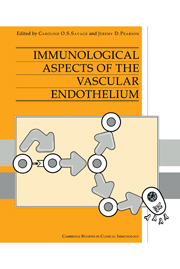Book contents
- Frontmatter
- Contents
- List of contributors
- Preface
- 1 New concepts of mechanisms in autoimmunity
- 2 Regulation of endothelial cell function by cytokines
- 3 Interactions between granulocytes and endothelium
- 4 The regulation of lymphocyte migration by vascular endothelium and its role in the immune response
- 5 Role of the vascular endothelium in immunologically mediated neurological diseases
- 6 The role of the endothelium in systemic lupus erythematosus and Sjögren's syndrome
- 7 The role of the endothelium in rheumatoid arthritis and scleroderma
- 8 The role of the endothelium in systemic vasculitis
- 9 Endothelial involvement in childhood Kawasaki disease
- 10 The role of the endothelium in thrombotic thrombocytopaenic purpura and haemolytic uraemic syndrome
- 11 The immunological role of the endothelium in organ transplantation
- Index
2 - Regulation of endothelial cell function by cytokines
Published online by Cambridge University Press: 04 August 2010
- Frontmatter
- Contents
- List of contributors
- Preface
- 1 New concepts of mechanisms in autoimmunity
- 2 Regulation of endothelial cell function by cytokines
- 3 Interactions between granulocytes and endothelium
- 4 The regulation of lymphocyte migration by vascular endothelium and its role in the immune response
- 5 Role of the vascular endothelium in immunologically mediated neurological diseases
- 6 The role of the endothelium in systemic lupus erythematosus and Sjögren's syndrome
- 7 The role of the endothelium in rheumatoid arthritis and scleroderma
- 8 The role of the endothelium in systemic vasculitis
- 9 Endothelial involvement in childhood Kawasaki disease
- 10 The role of the endothelium in thrombotic thrombocytopaenic purpura and haemolytic uraemic syndrome
- 11 The immunological role of the endothelium in organ transplantation
- Index
Summary
Introduction
Control of the access of soluble mediators and leukocytes to sites of inflammation and immune reactions is a crucial function of blood vessels, particularly within the microvasculature. Careful in vivo studies, especially those employing intravital microscopy, first revealed increases in small vessel permeability, apparently caused by direct action of inflammatory mediators on the endothelial cells, and altered properties of the endothelium provoking leukocyte adhesion and emigration (for review see Ryan & Majno, 1977).
Mainly in vitro studies of endothelial cells, starting in the early 1970s, have delineated a rapidly expanding range of properties of endothelium that actively contribute to the maintenance of vascular homeostasis and regulate blood vessel tone and permeability, blood coagulation and fibrinolysis (for review see Pearson, 1994). Following the recognition that communication between different leukocytes to orchestrate their specific functions was due to a variety of secreted polypeptides (the lymphokines) it became pertinent to examine whether endothelial cell properties relevant to the control of inflammatory and immune responses were, in addition, modulated by such molecules. This led, in the 1980s, to the first reports that the adhesive interactions between leukocytes and endothelium could be substantially enhanced by the action of either of two inflammatory cytokines, interleukin 1 (IL-1) and tumour necrosis factor (TNF), or bacterial endotoxins (lipopolysaccharide: LPS) on endothelial cells. Although LPS is not a cytokine, its effects on endothelial cells largely overlap with those of IL-1 and TNF, and it will be discussed in this context in this chapter.
- Type
- Chapter
- Information
- Immunological Aspects of the Vascular Endothelium , pp. 20 - 42Publisher: Cambridge University PressPrint publication year: 1995
- 4
- Cited by



